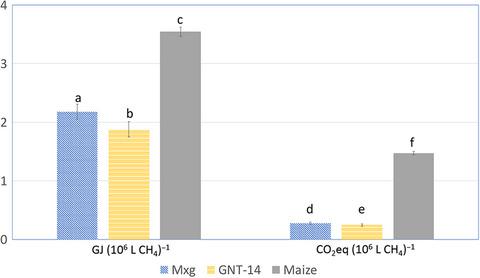当前位置:
X-MOL 学术
›
Food Energy Secur.
›
论文详情
Our official English website, www.x-mol.net, welcomes your
feedback! (Note: you will need to create a separate account there.)
A new carbohydrate retaining variety of Miscanthus increases biogas methane yields compared to M x giganteus and narrows the yield advantage of maize
Food and Energy Security ( IF 4.0 ) Pub Date : 2020-07-06 , DOI: 10.1002/fes3.224 Jason Kam 1 , David Thomas 1 , Sandra Pierre 1 , Chris Ashman 1 , Jon P. McCalmont 2 , Sarah J. Purdy 3
Food and Energy Security ( IF 4.0 ) Pub Date : 2020-07-06 , DOI: 10.1002/fes3.224 Jason Kam 1 , David Thomas 1 , Sandra Pierre 1 , Chris Ashman 1 , Jon P. McCalmont 2 , Sarah J. Purdy 3
Affiliation

|
Anaerobic digestion (AD) currently relies heavily on crop feedstocks to maintain a constant output. A major annual crop used is Zea mays (maize), but this practice presents significant concerns because high energy inputs and food‐growing land are required for cultivation. The autumn harvest date of maize exposes soils over winter resulting in erosion and runoff into waterways. Miscanthus is physiologically and morphologically similar to maize. It is also of interest for biogas generation. As a perennial grass, Miscanthus requires far less input and can be grown on land that is unsuitable for food crops. It is typically harvested in late winter to early spring. Maize produces higher biogas yields than the most commonly grown commercial variety of Miscanthus (Mxg), because it has a higher nonstructural carbohydrate (NSC) concentration that facilitates the AD process. We aimed to investigate whether a new Miscanthus hybrid (“GNT‐14”) that was bred from a high carbohydrate accumulating parental type can improve biogas yield from Mxg. Comparisons were made on biogas yields at two time points, October and January; the NSC, cellulose, and lignin concentrations were quantified; and the contribution of the NSC to biogas yield was determined by comparing intact and washed samples. The NSC concentrations of GNT‐14 were fivefold higher than Mxg in January, and a 28% increase in methane was observed. While Mxg showed a reduction in methane yields (L/kg) from biomass harvested in January compared to October, GNT‐14 showed no such decline. Although the potential methane yields of GNT‐14 were only 70% that of maize, the energy input (GJ ha‐1) required for cultivation was 26% of maize. Our results demonstrated that GNT‐14 could be harvested later than maize for biogas generation, offering soil protection over winter. We encourage Miscanthus breeding efforts to focus on NSC concentration as well as yield.
中文翻译:

与M x giganteus相比,一种新的保留芒草碳水化合物的品种增加了沼气的甲烷产量,并缩小了玉米的产量优势
目前,厌氧消化(AD)严重依赖农作物原料来维持恒定的产量。使用的主要年度作物是玉米(玉米),但是这种做法引起了极大的关注,因为种植需要大量的能源投入和粮食种植土地。玉米的秋季收获日期在冬季暴露于土壤,导致水蚀和径流进入水道。芒草在生理和形态上与玉米相似。对于沼气的产生也很感兴趣。作为多年生草,芒草需要的投入少得多,可以在不适合粮食作物的土地上种植。它通常在冬季末至初春收获。玉米产生的沼气产量高于最常见的商业品种芒草(Mxg),因为它具有较高的非结构性碳水化合物(NSC)浓度,可促进AD加工。我们的目的是研究从高糖蓄积亲本类型育成的新芒草杂种(“ GNT-14”)是否可以提高Mxg的沼气产量。在十月和一月的两个时间点对沼气产量进行了比较。对NSC,纤维素和木质素的浓度进行了定量。NSC对沼气产量的贡献通过比较完整样品和洗涤样品来确定。一月份,NSC的GNT-14浓度是Mxg的五倍,甲烷含量增加了28%。尽管Mxg与1月相比10月份从1月收获的生物量显示甲烷产量(L / kg)有所降低,但GNT-14却没有出现这种下降。尽管GNT-14的潜在甲烷产量仅为玉米的70%,但能量输入(GJ ha 在十月和一月的两个时间点对沼气产量进行了比较。对NSC,纤维素和木质素浓度进行定量;NSC对沼气产量的贡献通过比较完整样品和洗涤样品来确定。一月份,NSC的GNT-14浓度是Mxg的五倍,甲烷含量增加了28%。尽管Mxg与1月相比10月份从1月收获的生物量显示甲烷产量(L / kg)有所降低,但GNT-14却没有出现这种下降。尽管GNT-14的潜在甲烷产量仅为玉米的70%,但能量输入(GJ ha 在十月和一月的两个时间点对沼气产量进行了比较。对NSC,纤维素和木质素的浓度进行了定量。NSC对沼气产量的贡献通过比较完整样品和洗涤样品来确定。一月份,NSC的GNT-14浓度比Mxg高出五倍,甲烷含量增加了28%。尽管Mxg与1月相比10月份从1月收获的生物量显示甲烷产量(L / kg)有所降低,但GNT-14却没有出现这种下降。尽管GNT-14的潜在甲烷产量仅为玉米的70%,但能量输入(GJ ha 一月份,NSC的GNT-14浓度是Mxg的五倍,甲烷含量增加了28%。尽管Mxg与1月相比10月份从1月收获的生物量显示甲烷产量(L / kg)有所降低,但GNT-14却没有出现这种下降。尽管GNT-14的潜在甲烷产量仅为玉米的70%,但能量输入(GJ ha 一月份,NSC的GNT-14浓度是Mxg的五倍,甲烷含量增加了28%。尽管Mxg与1月相比10月份从1月收获的生物量显示甲烷产量(L / kg)有所降低,但GNT-14却没有出现这种下降。尽管GNT-14的潜在甲烷产量仅为玉米的70%,但能量输入(GJ ha-1)种植所需的玉米占玉米的26%。我们的结果表明,GNT-14的收获时间可能比玉米晚,以产生沼气,从而在冬季提供土壤保护。我们鼓励芒草的育种工作集中在NSC的浓度和产量上。
更新日期:2020-07-06
中文翻译:

与M x giganteus相比,一种新的保留芒草碳水化合物的品种增加了沼气的甲烷产量,并缩小了玉米的产量优势
目前,厌氧消化(AD)严重依赖农作物原料来维持恒定的产量。使用的主要年度作物是玉米(玉米),但是这种做法引起了极大的关注,因为种植需要大量的能源投入和粮食种植土地。玉米的秋季收获日期在冬季暴露于土壤,导致水蚀和径流进入水道。芒草在生理和形态上与玉米相似。对于沼气的产生也很感兴趣。作为多年生草,芒草需要的投入少得多,可以在不适合粮食作物的土地上种植。它通常在冬季末至初春收获。玉米产生的沼气产量高于最常见的商业品种芒草(Mxg),因为它具有较高的非结构性碳水化合物(NSC)浓度,可促进AD加工。我们的目的是研究从高糖蓄积亲本类型育成的新芒草杂种(“ GNT-14”)是否可以提高Mxg的沼气产量。在十月和一月的两个时间点对沼气产量进行了比较。对NSC,纤维素和木质素的浓度进行了定量。NSC对沼气产量的贡献通过比较完整样品和洗涤样品来确定。一月份,NSC的GNT-14浓度是Mxg的五倍,甲烷含量增加了28%。尽管Mxg与1月相比10月份从1月收获的生物量显示甲烷产量(L / kg)有所降低,但GNT-14却没有出现这种下降。尽管GNT-14的潜在甲烷产量仅为玉米的70%,但能量输入(GJ ha 在十月和一月的两个时间点对沼气产量进行了比较。对NSC,纤维素和木质素浓度进行定量;NSC对沼气产量的贡献通过比较完整样品和洗涤样品来确定。一月份,NSC的GNT-14浓度是Mxg的五倍,甲烷含量增加了28%。尽管Mxg与1月相比10月份从1月收获的生物量显示甲烷产量(L / kg)有所降低,但GNT-14却没有出现这种下降。尽管GNT-14的潜在甲烷产量仅为玉米的70%,但能量输入(GJ ha 在十月和一月的两个时间点对沼气产量进行了比较。对NSC,纤维素和木质素的浓度进行了定量。NSC对沼气产量的贡献通过比较完整样品和洗涤样品来确定。一月份,NSC的GNT-14浓度比Mxg高出五倍,甲烷含量增加了28%。尽管Mxg与1月相比10月份从1月收获的生物量显示甲烷产量(L / kg)有所降低,但GNT-14却没有出现这种下降。尽管GNT-14的潜在甲烷产量仅为玉米的70%,但能量输入(GJ ha 一月份,NSC的GNT-14浓度是Mxg的五倍,甲烷含量增加了28%。尽管Mxg与1月相比10月份从1月收获的生物量显示甲烷产量(L / kg)有所降低,但GNT-14却没有出现这种下降。尽管GNT-14的潜在甲烷产量仅为玉米的70%,但能量输入(GJ ha 一月份,NSC的GNT-14浓度是Mxg的五倍,甲烷含量增加了28%。尽管Mxg与1月相比10月份从1月收获的生物量显示甲烷产量(L / kg)有所降低,但GNT-14却没有出现这种下降。尽管GNT-14的潜在甲烷产量仅为玉米的70%,但能量输入(GJ ha-1)种植所需的玉米占玉米的26%。我们的结果表明,GNT-14的收获时间可能比玉米晚,以产生沼气,从而在冬季提供土壤保护。我们鼓励芒草的育种工作集中在NSC的浓度和产量上。











































 京公网安备 11010802027423号
京公网安备 11010802027423号